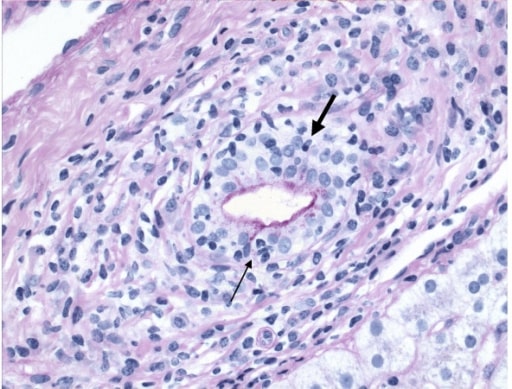Playlist
Show Playlist
Hide Playlist
Primary Biliary Cholangitis with Case
-
Slides Gastroenterology 15 Billiary System Pt2 Cholestatic Diseases.pdf
-
Reference List Gastroenterology.pdf
-
Download Lecture Overview
00:00 Welcome. 00:01 Today we'll discuss even further disorders of the biliary system. 00:05 And we'll focus on cholestatic liver diseases. 00:09 So let's begin with a case. 00:11 A 65-year-old woman presents to clinic with 4 months of fatigue, pruritus and dry eyes. 00:18 She does not have fever, chills, jaundice, rashes, night sweats or weight loss. 00:23 She has a history of hyperlipidemia for which she takes rosuvastatin. 00:27 She has no other medical problems. 00:29 Vitals are normal, physical exam is unremarkable. 00:32 No rashes are noted. 00:35 Her labs are notable for an ALT of 75 (U/L), AST 45 (U/L), alkaline phosphatase 420 (U/L) and total bilirubin 1.5 (mg/dL) In addition, her antimitochondrial antibody titer is 1:640 A right upper quadrant ultrasound is normal. 00:53 What is the most likely diagnosis? So let's point out here that she has had 4 months of kind of vague symptoms with generalized pruritis without a rash, which would prompt you to think of a systemic disorder. 01:07 She also has a cholestatic pattern elevation of her hepatic panel. 01:12 So, a primarily elevation in her alkaline phosphatase and the total bilirubin out of proportion to the ALT and AST. 01:21 In addition, she has this elevated AMA antibody which we will discuss. 01:27 So, now let's discuss a condition called primary biliary cholangitis. 01:33 This is an immune-mediated disease where the small interlobular bile ducts get destroyed by the autoimmune process. 01:42 It mostly affects middle-aged women and can cause hypercholesterolemia so patients will come in presenting with fatigue, generalized pruritus so a feeling of being itchy everywhere, jaundice and dry eyes. 01:59 On physical exam, you may see evidence of hyperpigmentation or darkening of the skin, they may have xanthelasmas or xanthomas which are findings of high cholesterol which we'll discuss later and hepatomegaly or an enlarged liver. 02:14 The diagnosis is made by finding this cholestatic pattern of elevation in the liver enzymes. 02:20 So again, that means a predominant elevation in the alkaline phosphatase, GGT and bilirubin. 02:27 You may also confirm the diagnosis with a positive antimitochondrial antibody. 02:34 So, we mentioned this physical exam findings of xanthelasma and xanthoma. 02:40 A xanthelasma is simply a fatty cholesterol deposit on the eyelid as shown here. 02:48 A xanthoma is a very similar finding except that it is a deposit on the skin and usually over the joints. 02:54 So here you can see multiple xanthomas overlying the joints of the hands. 03:02 So treatments of this condition involves giving a medication called Ursodiol to slow progression of the disease. 03:09 You will also treat them for their symptoms, so antihistamines to treat their pruritus, and artificial tears for their dry eyes. 03:16 And when the disease continue to progress, you may refer for liver transplantation evaluation. 03:23 So now let's go back to our case. 03:25 Our 65-year-old woman who's coming in with vague symptoms of pruritus, no rashes. 03:31 She has a cholestatic pattern of elevation on her hepatic panel and she has an elevated AMA antibody which should prompt you to think of two particular diagnoses: autoimmune hepatitis or primary biliary cholangitis. 03:46 In her case, she does not have a hepatocellular pattern of injury on her liver test so the most likely diagnosis here, is PBC. 03:55 In addition, her positive anti-mitochondrial antibody will help you confirm this diagnosis.
About the Lecture
The lecture Primary Biliary Cholangitis with Case by Kelley Chuang, MD is from the course Disorders of the Hepatobiliary Tract.
Included Quiz Questions
Which of the following antibodies is specific for primary biliary cholangitis?
- Antimitochondrial antibodies
- Antinuclear antibodies
- Anti-Smith antibodies
- Anticentromere antibodies
- Anti-dsDNA antibodies
Which of the following is the treatment of choice for late-stage primary biliary cholangitis that progresses on medical therapy?
- Liver transplantation
- Ursodiol
- Antihistamines
- Artificial tears
- Antibiotics
Customer reviews
5,0 of 5 stars
| 5 Stars |
|
5 |
| 4 Stars |
|
0 |
| 3 Stars |
|
0 |
| 2 Stars |
|
0 |
| 1 Star |
|
0 |





